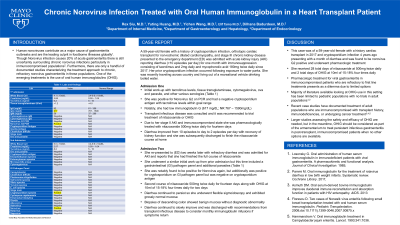Monday Poster Session
Category: Colon
P1688 - Chronic Norovirus Infection Treated With Oral Immunoglobulin in a Heart Transplant Patient
Monday, October 23, 2023
10:30 AM - 4:15 PM PT
Location: Exhibit Hall

Has Audio
.jpg)
Yuting Huang, MBBS, PhD
Mayo Clinic Florida
Jacksonville, FL
Presenting Author(s)
Yuting Huang, MBBS, PhD1, Yichen Wang, MD, MSc2, Rex Siu, MD, MSc1, Abdellah Hedjoudje, MD3, Dilhana Badurdeen, MD1
1Mayo Clinic Florida, Jacksonville, FL; 2Mercy Internal Medicine Service, Trinity Health of New England, Springfield, MA; 3Beaujon Hospital, Clichy, Ile-de-France, France
Introduction: The etiology of diarrhea in patients on immunosuppressant medications can be a diagnostic dilemma. Chronic Norovirus infection is rare and treatment options are limited.
Case Description/Methods: A 59-year-old female with a history of orthotopic cardiac transplantation for non-ischemic dilated cardiomyopathy and Chronic Kidney Disease stage III was admitted with acute kidney injury due to diarrhea for the past month. She had 15-20 watery non-bloody bowel movements daily with 14 lbs. weight loss. Of note, she was traveling cross-country in a recreational vehicle. Her immunosuppressant regimen consisted of Tacrolimus 2 mg and Mycophenolic acid 180mg twice per day with no history of rejection. Her husband was asymptomatic.
She tested positive for Norovirus and Cryptosporidium on GI pathogen panel PCR. The patient was treated with Nitazoxanide 500mg bid for 14 days. Diarrhea and kidney function improved, and she was discharged. Unfortunately, she was re-admitted 1 week later with worsening diarrhea. Norovirus and Cryptosporidium remained positive on GI pathogen panel PCR, but Cryptosporidium Ag was negative. Tacrolimus level was at goal, but she was found to have hypogammaglobulinemia (IgG 617 mg/dL low, IgM 59 mg/dL and IgA 93 mg/dL are lower limits of normal).
Subsequent flexible sigmoidoscopy showed normal mucosa in the examined colon and benign pathology. The decision was made to administer 10ml of 15-18% oral human immunoglobulin (OHIG) orally every 6 hours for a total of 8 doses while continuing Nitazoxanide. Diarrhea gradually improved but, Norovirus PCR tested positive for 2 months.
Discussion: OHIG has been primarily reported for use in pediatric populations in the treatment of Rotavirus diarrhea and prevention of necrotizing enterocolitis. However, its use has expanded to treatment of Campylobacter Jejuni, Norwalk virus, and Norovirus in immunocompromised patients, such as those with HIV, common variable immunodeficiency, Inflammatory Bowel Disease and post-transplant individuals. OHIG improves intestinal permeability, alters microflora, and has immunomodulatory effects. Intravenous immunoglobulins (IVIG) are ineffective in treating enteritis due to the intact gut lumen which supports the use of oral route. Our patients borderline low immunoglobulins in the setting of immunosuppression likely played a role in her chronic enteritis. Thus, OHIG should be a part of the armamentarium to treat persistent infectious diarrhea in post-transplant immunocompromised patients.
Disclosures:
Yuting Huang, MBBS, PhD1, Yichen Wang, MD, MSc2, Rex Siu, MD, MSc1, Abdellah Hedjoudje, MD3, Dilhana Badurdeen, MD1. P1688 - Chronic Norovirus Infection Treated With Oral Immunoglobulin in a Heart Transplant Patient, ACG 2023 Annual Scientific Meeting Abstracts. Vancouver, BC, Canada: American College of Gastroenterology.
1Mayo Clinic Florida, Jacksonville, FL; 2Mercy Internal Medicine Service, Trinity Health of New England, Springfield, MA; 3Beaujon Hospital, Clichy, Ile-de-France, France
Introduction: The etiology of diarrhea in patients on immunosuppressant medications can be a diagnostic dilemma. Chronic Norovirus infection is rare and treatment options are limited.
Case Description/Methods: A 59-year-old female with a history of orthotopic cardiac transplantation for non-ischemic dilated cardiomyopathy and Chronic Kidney Disease stage III was admitted with acute kidney injury due to diarrhea for the past month. She had 15-20 watery non-bloody bowel movements daily with 14 lbs. weight loss. Of note, she was traveling cross-country in a recreational vehicle. Her immunosuppressant regimen consisted of Tacrolimus 2 mg and Mycophenolic acid 180mg twice per day with no history of rejection. Her husband was asymptomatic.
She tested positive for Norovirus and Cryptosporidium on GI pathogen panel PCR. The patient was treated with Nitazoxanide 500mg bid for 14 days. Diarrhea and kidney function improved, and she was discharged. Unfortunately, she was re-admitted 1 week later with worsening diarrhea. Norovirus and Cryptosporidium remained positive on GI pathogen panel PCR, but Cryptosporidium Ag was negative. Tacrolimus level was at goal, but she was found to have hypogammaglobulinemia (IgG 617 mg/dL low, IgM 59 mg/dL and IgA 93 mg/dL are lower limits of normal).
Subsequent flexible sigmoidoscopy showed normal mucosa in the examined colon and benign pathology. The decision was made to administer 10ml of 15-18% oral human immunoglobulin (OHIG) orally every 6 hours for a total of 8 doses while continuing Nitazoxanide. Diarrhea gradually improved but, Norovirus PCR tested positive for 2 months.
Discussion: OHIG has been primarily reported for use in pediatric populations in the treatment of Rotavirus diarrhea and prevention of necrotizing enterocolitis. However, its use has expanded to treatment of Campylobacter Jejuni, Norwalk virus, and Norovirus in immunocompromised patients, such as those with HIV, common variable immunodeficiency, Inflammatory Bowel Disease and post-transplant individuals. OHIG improves intestinal permeability, alters microflora, and has immunomodulatory effects. Intravenous immunoglobulins (IVIG) are ineffective in treating enteritis due to the intact gut lumen which supports the use of oral route. Our patients borderline low immunoglobulins in the setting of immunosuppression likely played a role in her chronic enteritis. Thus, OHIG should be a part of the armamentarium to treat persistent infectious diarrhea in post-transplant immunocompromised patients.
Disclosures:
Yuting Huang indicated no relevant financial relationships.
Yichen Wang indicated no relevant financial relationships.
Rex Siu indicated no relevant financial relationships.
Abdellah Hedjoudje indicated no relevant financial relationships.
Dilhana Badurdeen indicated no relevant financial relationships.
Yuting Huang, MBBS, PhD1, Yichen Wang, MD, MSc2, Rex Siu, MD, MSc1, Abdellah Hedjoudje, MD3, Dilhana Badurdeen, MD1. P1688 - Chronic Norovirus Infection Treated With Oral Immunoglobulin in a Heart Transplant Patient, ACG 2023 Annual Scientific Meeting Abstracts. Vancouver, BC, Canada: American College of Gastroenterology.
